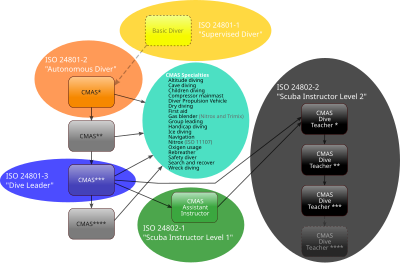

CMAS one-star scuba diver (also known as CMAS * diver, or just CMAS *) is the entry-level diving certification for recreational scuba diving issued by the Confédération Mondiale des Activités Subaquatiques (CMAS).
The training programme enables divers to undertake accompanied no-decompression dives to a maximum depth of 20 meters in open water.[1] Other countries affiliated to CMAS may allow higher limits (for example, the Irish Underwater Council certifies a CMAS * diver to dive to 25m or 30m depending on the dive buddy, both at home and abroad).[2]
In the CMAS International Diver Training Standards and Procedures Manual, CMAS states that "A one-star diver shall be deemed to have sufficient knowledge, skill and experience to procure air, equipment, and other diving services and to plan, conduct, and log open-water dives that do not require mandatory in-water decompression stops, without the supervision of a CMAS instructororCMAS dive leader, when properly equipped and accompanied by another certified diver of at least the same level, provided the diving activities undertaken, the diving conditions and the diving area are similar, equal or better to those in which training was received."[3]
CMAS one-star scuba divers can undertake accompanied no-decompression dives to a maximum depth of 20 meters in open water.

The Confédération mondiale des activités subaquatiques (world underwater federation) was created in 1959 to bring consistency between different national diving certification systems.
As a result, the CMAS one-star diver certification is usually delivered as an equivalence to a national one-star diver certification delivered through a federation affiliated to the CMAS Technical Committee.[4][5][6]
| Country | Affiliated organisation [7] | Equivalent certification |
|---|---|---|
| France | FFESSM | Level-1 diver ("plongeur niveau 1") |
| Belgium | Royal Belgian Diving Federation (BEFOS-FEBRAS) | Level-1 diver |
| Spain | FEDAS | Level-1 diver |
| Great Britain | Sub-Aqua Association | Open Water Diver [8] |
The CMAS one-star diver certification can also be delivered by specially accredited dive centers known as CMAS Dive Centers (CDC) who use dedicated CMAS training materials and who directly issue CMAS diving certificates.[9]
The course covers the following theory topics:[10]
and the following practical skills:
Following the training, five successful open water dives are required to complete the certification.[10]
The course has the following minimum requirements:
Although the CMAS* Diver standard is a minimum requirement, individual CMAS Federations may recommend or require higher standards or extra coverage for their entry-level certification to suit local conditions and requirements. For example, the Sub-Aqua Association in the UK places extra emphasis on the theory and prevention of decompression sickness, diving from small boats and cold-water diving.[11]